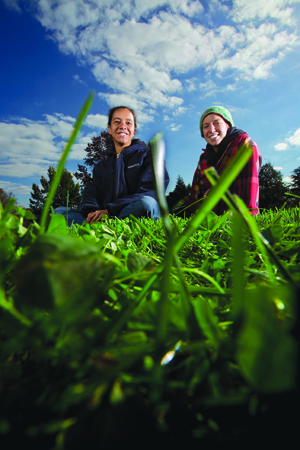A Transition to Organic: Lawns Go Greener

College gardener Nicole Selby ’02 (left) and Camille Robertson ’13 admire the organic grasses they planted on Parrish Lawn. Photo by Laurence Kesterson
It was clear to anyone visiting Swarthmore’s campus this fall that something had changed. No students were sitting on Parrish Lawn, plastic-string fencing bordered its edges, and the iconic giant Adirondack chair sat at the base of the downsloping area rather than in its usual perch at the top.
Although the change might have been slightly jarring at first, it actually signaled a major stepping-stone in the College’s increasing sustainability efforts. Since 2010, various campus green spaces have been transitioning from conventional to organic lawn treatment, using an all-natural approach rather than synthetic pesticides and fertilizers.
The food industry has long been moving in an organic direction, but the organic trend hasn’t caught on as rapidly with those who tend recreational surfaces, like lawns. At Swarthmore, one of the first institutions to make a transition of this sort, grounds and arboretum staff have been inspired, in part, by leaders of other innovative public projects.
“About 80 acres of the gardens and parks in Philadelphia are maintained organically by the Pennsylvania Horticultural Society’s Philadelphia Green program,” says Jeff Jabco, coordinator of horticulture at the Scott Arboretum and the College’s director of grounds. Jabco and other College employees interested in that program also investigated a soil-restoration project at Harvard University and one at the Battery Park City Parks Conservancy, which is all organic. After Jabco worked with the Harvard project’s director, the next steps for Swarthmore became clear. “We already have leading sustainability initiatives, like green roofs on several dormitories, so this transition seemed necessary,” he says.
Although the organic approach has been implemented on approximately 6.33 acres of campus lawn thus far, perhaps the most notable aspect of this work is taking place on Parrish Beach, a focal point for the project.
“Parrish Beach is always filled with students, so we knew it made sense that this should be one of the first places to go organic, so students can enjoy it with all-natural, rather than potentially harmful inorganic techniques to maintain it,” says gardener Nicole Selby ’02. “Fertilizer and pesticide vapors and dusts can enter the body through inhalation or skin penetration, and residues can wind up being ingested if they’re unknowingly transferred to one’s hands.”
Selby, a key leader of the transition, has been a gardener with the College for six years. She contributes much past experience combined with a personal interest, which began in her student days.
“I lived in Mertz dorm as a freshman, and I think it’s neat that this initiative began on Mertz Lawn,” says Selby. “I gain extra motivation from how special this campus is to me, having been a part of my life for many of the last 14 years. I’ve spent countless hours on the lawns and along the Crum Creek with my daughter, and I feel impassioned to make them as wholesome, safe, and natural as possible for all the families in our community.”
One of the key components of the organic lawn initiative was involvement and support from students and faculty.
“A lot of the natural-science faculty members and students have expressed interest in the project,” says Jabco. “Some have examined the effect that going organic has had on earthworms, have examined compost, and have made it a topic in class discussions. Some student groups like Ecosphere and others interested in the project have requested tours with a green focus to learn more about this process.”
Several current students were involved with the transition to organic.
“This job was interesting in particular because it had a lab aspect,” says Anirban Ganguly ’15, who was an organic lawn initiative assistant with the grounds department’s gardeners. “I spread fertilizer, independently used lysimeters to collect soil water samples, and performed nutrient tests for nitrogen and phosphorous. I also took photos of the lawn on a monthly basis to qualitatively track lawn health.”
The project’s presence fits in with an overall mission to make the school a model of a more environmentally conscious society.
“Our organic lawn trials serve not only to improve our own ecological footprint but to educate and inspire other institutions to make strides,” says Selby. “The environmental benefits are magnified by raising awareness among our students and the local community and, hopefully, influencing their decisions as homeowners, consumers, and leaders in their professions.
 Email This Page
Email This Page